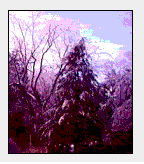

Snow on Snow*


Excerpts from the Snow Almanac:
Snowstorms in New England
Snowstorms occur in New England when a warm moist mass of air spinning counterclockwise (a low pressure system) moving up from the south meets a mass of cold dry air swirling clockwise (a high pressure system) moving down from the north.
If the cold air mass moves into a warm mass , it slips under the warm moist air, pushing the warmer air to a colder altitude where it condenses to snow and falls to the earth.
A more common winter storm condition in New England finds the warm air moving into an established cold air mass. The warm, wet air rises over the cold air and freezes as it falls through the cold layer. These warm front storms tend to last longer than cold front storms.
Blizzards
- The U.S. Weather Bureau definition:
- A snowstorm with winds of at least 35 mph, temperatures 20 degrees F or lower over the period of the storm is a plain "blizzard."
- A severe blizzard has 45 mph or greater winds, blowing snow and temperatures at 10 degrees F or below.
- The first "unofficial, recorded" blizzard in the United States:
- In the 1870's an Iowa newspaper used the word "blizzard to describe a snowstorm. Previously the term, blizzard, referred to a canon shot or a volley of musket fire. By the 1880's, snow "blizzards" were spoken of all across the United States and in England.
- One root of the word: from the German, blitz, meaning lightning.
Nor'easter
- This is the coastal warm front storm which typically strikes New England in February:
- Warm moist air picked up in the tropics moves north up the coast.
- A mass of polar air from Eastern Canada and the North Atlantic moves south
- Somewhere in the vicinity of Cape Cod the warm air hits the cold air.
- The warm air moves up and over the the cold layer.
- Snow crystals form and fall
- If the storm moves quickly, cold rain or snow will fall for six to eight hours.
- If the warm air stalls against a high pressure wall, the snowfall may last 12-24 or more hours as it did in the blizzards of 1888, 1969, 1978, and 1996.
The Blizzard of '88
On Sunday, March 11, 1888, a nor'easter stalled over New York City, dumping 21 inches of snow. Seventy mph gusts piled up 20 foot drifts, marooning New Yorkers in elevated trains, carriages and office buildings.
Does this sound familiar?
On January 7 and 8 of 1996 28 inches of snow fell in New York City, but winds were less severe than in 1888.
The 1888 blizzard extended from Maine to Washington, D.C., and from New York to Pittsburgh. The storm stalled for a day and a half. In Connecticut and central Massachusetts, 40-50 inches of snow fell. Winds piled up 40 to 50 foot drifts. Houses and trains were buried.
From Chesapeake Bay to Nantucket, two hundred ships were sunk or severely damaged. In '88, four hundred lives were lost, a tragedy that modern weather forecasting has spared us.
1816:The Year without Summer
- Recent winter weather woes in the East can't compare to "winter" weather that befell the area in June and July of 1816:
- Connecticut experienced a rare summer blizzard.
- Snow and sleet fell in Danville, Vermont.
- Massachusetts had snow flurries.
- An unseasonably frigid summer brought crop failures all over New England.
- Savannah Georgia has a high temperature of only 46 degrees F on July 4.
- Some speculated that Judgement day was near, Others attributed the unusually cold summer across the country to the massive amounts of dust and ash spewed into the atmosphere by the eruption of the Tambora volcano in Java the previous year.
Watch for new entries and links over the course of the winter.
A CitySource-designed page, digitized photographs and text copyright CitySource Inc. 1995. All rights reserved. Almanac text copyright 1981, 1995, 1996 by J.Snow